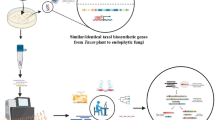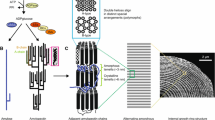Abstract
Zygotes of the brown alga Fucus distichus (L.) Powell develop polarity prior to the first embryonic cell division and retain a pattern of asymmetric growth during early embryogenesis. In order to identify F. distichus polypeptides secreted during asymmetric cell growth, we used a functional assay in Saccharomyces cerevisiae to screen a cDNA library generated from asymmetrically growing Fucus embryos for sequences encoding polypeptides that function as signal peptides for secretion. We isolated and sequenced 222 plasmids containing Fucus cDNAs encoding signal peptide activity. The cDNA inserts from these plasmids were translated in silico into 244 potential polypeptide sequences, 169 of which are predicted to contain signal peptides. BlastP analysis of the Fucus sequences revealed similarity between many Fucus proteins and cell surface proteins that function in development in other eukaryotes, including epidermal growth factor (EGF)-like repeat-containing proteins, plant leucine-rich repeat (LRR)-receptor kinases, and algal β-1, 3-exoglucanase. However, most of the isolated Fucus polypeptides lack similarity to known proteins. The isolation of cDNAs encoding secreted Fucus proteins provides an important step toward characterizing cell surface proteins important for asymmetric organization and growth in fucoid embryos.



Similar content being viewed by others
Abbreviations
- ECM:
-
extracellular matrix
- EGF:
-
epidermal growth factor
- ER:
-
endoplasmic reticulum
- LRR:
-
leucine-rich repeat
- SST:
-
signal sequence trap
- WAK:
-
wall-associated kinase
References
Altschul SF, Gish W, Miller W, Myers EW, Lipman DJ (1990) Basic local alignment search tool. J Mol Biol. 215:403–410
An YQ, McDowell JM, Huang S, McKinney EC, Chambliss S, Meagher RB (1996) Strong, constitutive expression of the Arabidopsis ACT2/ACT8 actin subclass in vegetative tissues. Plant J 10:107–121
Appel RD, Bairoch A, Hochstrasser DF (1994) A new generation of information retrieval tools for biologists: the example of the ExPASy WWW server. Trends Biochem.Sci 19:258–260
Apt KE, Clendennen SK, Powers DA, Grossman AR (1995) The gene family encoding the fucoxanthin chlorophyll proteins from the brown alga Macrocystis pyrifera. Mol Gen Genet 246:455–464
Ausubel FM, Brent R, Kingston RE, Moore DD, Seidman JG, Smith JA, Struhl KJ (eds) (1995) Current protocols in molecular biology. Wiley, New York, chpt 13
Belanger KD, Quatrano RS (2000a) Polarity: the role of localized secretion. Curr Opin Plant Biol 3:67–72
Belanger KD, Quatrano RS (2000b) Membrane recycling occurs during asymmetric tip growth and cell plate formation in Fucus distichus zygotes. Protoplasma 212:24–37
Bork P, Downing AK, Kieffer B, Campbell ID (1996) Structure and distribution of modules in extracellular proteins. Q Rev Biophys 29:119–167
Brawley SH, Quatrano RS (1979) Sulfation of fucoidin in Fucus embryos. 4. Autoradiographic investigations of fucoidin sulfation and secretion during differentiation and the effects of cytochalasin treatment. Dev Biol 73:193–205
Brownlee C, Bouget FY (1998) Polarity determination in Fucus: from zygote to multicellular embryo. Semin Cell Dev Biol 9:179–185
Brownlee C, Bouget F-Y, Corellou F (2001) Choosing sides: establishment of polarity in zygotes of fucoid algae. Semin Cell Dev Biol 12:345–351
Cheong YH, Kim CY, Chun HJ, Moon BC, Park HC, Kim JK, Lee SH, Han CD, Lee SY, Cho MJ (2000) Molecular cloning of a soybean class III beta-1,3-glucanase gene that is regulated both developmentally and in response to pathogen infection. Plant Sci 154:71–81
Cove DJ (2000) The generation and modification of cell polarity. J Exp Bot 51:831–838
Doe CQ, Bowerman B (2001) Asymmetric cell division: fly neuroblast meets worm zygote. Curr Opin Cell Biol 13:68–75
Drgonova J, Drgon T, Tanaka K, Kollar R, Chen GC, Ford RA, Chan CS, Takai Y, Cabib E (1996) Rho1p, a yeast protein at the interface between cell polarization and morphogenesis. Science 272:277–279
Drubin DG, Nelson WJ (1996) Origins of cell polarity. Cell 84:335–344
Emanuelsson O, Nielsen H, von Heijne G (1999) ChloroP, a neural network-based method for predicting chloroplast transit peptides and their cleavage sites. Protein Sci 8:978–984
Gollan L, Sabanay H, Poliak S, Berglund EO, Ranscht B, Peles E (2002) Retention of a cell adhesion complex at the paranodal junction requires the cytoplasmic region of Caspr. J Cell Biol 157:1247–1256
Goo JH, Park AR, Park WJ, Park OK (1999) Selection of Arabidopsis genes encoding secreted and plasma membrane proteins. Plant Mol Biol 41:415–423
Grebe M, Xu J, Scheres B (2001) Cell axiality and polarity in plants—adding pieces to the puzzle. Curr Opin Plant Biol 4:520–526
Hable WE, Kropf DL (1998) Roles of secretion and the cytoskeleton in cell adhesion and polarity establishment in Pelvetia compressa zygotes. Dev Biol 198:45–56
Hable WE, Kropf DL (2000) Sperm entry induces polarity in fucoid zygotes. Development 127:493–501
He Z-H, He D, Kohorn BD (1998) Requirement for the induced expression of a cell wall associated receptor kinase for survival during the pathogen response. Plant J 14:55–63
He Z-H, Cheeseman I, He D, Kohorn BD (1999) A cluster of five cell wall-associated receptor kinase genes, Wak1-5, are expressed in specific organs of Arabidopsis. Plant Mol Biol 39:1189–1196
Helleboid S, Chapman A, Hendriks T, Inze D, Vasseur J, Hilbert JL (2000) Cloning of beta-1,3-glucanases expressed during Cichorium somatic embryogenesis. Plant Mol Biol 42:377–386
Ito H, Fukuda Y, Murata K, Kimura A (1983) Transformation of intact yeast cells treated with alkali cations. J Bacteriol 153:163–168
Jacobs KA, Collins-Racie LA, Colbert M, Duckett M, Golden-Fleet M, Kelleher K, Kriz R, LaVallie ER, Merberg D, Spaulding V, Stover J, Williamson MJ, McCoy JM (1997) A genetic selection for isolating cDNAs encoding secreted proteins. Gene 198:289–296
Jinn T, Stone J, Walker J (2000) HAESA, an Arabidopsis leucine-rich repeat receptor kinase, controls floral organ abscission. Genes Dev 11:108–117
Johnson AE, van Waes MA (1999) The translocon: a dynamic gateway at the ER membrane. Annu Rev Cell Dev Biol 15:799–842
Kaiser CA, Preuss D, Grisafi P, Botstein D (1987) Many random sequences functionally replace the secretion signal sequence of yeast invertase. Science 235:312–317
Klein RD, Gu Q, Goddard A, Rosenthal A (1996) Selection for genes encoding secreted proteins and receptors. Proc Natl Acad Sci USA 93:7108–7113
Kropf DL (1997) Induction of polarity in fucoid zygotes. Plant Cell 9:1011–1020
Lally D, Ingmire P, Tong H-Y, He Z-H (2001) Antisense expression of a cell wall-associated protein kinase, WAK4, inhibits cell elongation and alters morphology. Plant Cell 13:1317–1332
Li J, Chory J (1997) A putative leucine-rich repeat receptor kinase involved in brassinosteroid signal transduction. Cell 90:929–938
Li J, Wen J, Lease KA, Doke JT, Tax FE, Walker JC (2002) BAK1, an Arabidopsis LRR receptor-like protein kinase, interacts with BRI1 and modulates brassinosteroid signaling. Cell 110:213–222
Li Z, Wurtzel ET (1998) The ltk gene family encodes novel receptor-like kinases with temporal expression in developing maize endosperm. Plant Mol Biol 37:749–761
Martoglio B, Dobberstein B (1998) Signal sequences: more than just greasy peptides. Trends Cell Biol 8:410–415
Nakai K, Kanehisa M (1992) A knowledge base for predicting protein localization sites in eukaryotic cells. Genomics 14:897–911
Nam KH, Li J (2002) BRI1/BAK1, a receptor kinase pair mediating brassinosteroid signaling. Cell 110:203–212
Ngsee JK, Hansen W, Walter P, Smith M (1989) Cassette mutagenic analysis of the yeast invertase signal peptide: effects on protein translocation. Mol Cell Biol 9:3400–3410
Nielsen H, Engelbrecht J, Brunak S, von Heijne G (1997) Identification of prokaryotic and eukaryotic signal peptides and prediction of their cleavage sites. Protein Eng 10:1–6
Novotny AM, Forman M (1974) The relationship between changes in cell wall composition and the establishment of polarity in Fucus embryos. Dev Biol 40:162–173
Peles E, Salzer JL (2000) Molecular domains of myelinated axons. Curr Opin Neurobiol 10:558–565
Pihakaski-Maunsbach K, Griffith M, Antikainen M, Maunsbach AB (1996) Immunogold localization of glucanase-like antifreeze protein in cold acclimated winter rye. Protoplasma 191:115–125
Pu R.S, Wozniak M, Robinson KR (2000) Cortical actin filaments form rapidly during photopolarization and are required for the development of calcium gradients in Pelvetia compressa zygotes. Dev Biol 222:440–449
Qadota H, Python CP, Inoue SB, Arisawa M, Anraku Y, Zheng Y, Watanabe T, Levin DE, Ohya Y (1996) Identification of yeast Rho1p GTPase as a regulatory subunit of 1,3-beta-glucan synthase. Science 272:279–281
Quatrano RS (1982) Cell-wall formation in Fucus zygotes: a model system to study the assembly and localization of wall polymers. In: Brown RM (ed) Cellulose and other natural polymer systems. Plenum, London, pp 45–59
Quatrano RS (1997) Cortical asymmetries direct the establishment of cell polarity and the plane of cell division in the Fucus embryo. Cold Spring Harbor Symp Quant Biol 62:65–70
Quatrano RS, Crayton MA (1973) Sulfation of fucoidan in Fucus embryos I: possible role in localization. Dev Biol 30:29–35
Quatrano RS, Shaw S (1997) Role of the cell wall in the determination of cell polarity and the plane of cell division in Fucus embryos. Trends Plant Sci 2:15–21
Rao Z, Handford P, Mayhew M, Knott V, Brownlee GG, Stuart D (1995) The structure of a Ca2+-binding epidermal growth factor-like domain: its role in protein-protein interactions. Cell 82:131–141
Shaw SL, Quatrano RS (1996) Polar localization of a dihydropyridine receptor on living Fucus zygotes. J Cell Sci 109:335–342
Shiu SH, Bleecker AB (2001) Receptor-like kinases from Arabidopsis form a monophyletic gene family related to animal receptor kinases. Proc Natl Acad Sci USA 98:10763–10768
Simmons CR (1994) The physiology and molecular biology of plant 1,3-β-d-glucanases and 1,3;1,4-β-d-glucanases. Crit Rev Plant Sci 13:325–387
Singson A, Mercer KB, L'Hernault SW (1998) The C. elegans spe-9 gene encodes a sperm transmembrane protein that contains EGF-like repeats and is required for fertilization. Cell 93:71–79
Stevens PT, Quatrano RS (1978) Cell wall assembly in Fucus zygotes. II. Cellulose synthesis and deposition is controlled at the post-translational level. Dev Biol 62:518–525
Strutt D, Johnson R, Cooper K, Bray S (2002) Asymmetric localization of frizzled and the determination of notch-dependent cell fate in the Drosophila eye. Curr Biol 12:813–824
Torii KU (2000) Receptor kinase activation and signal transduction in plants: an emerging picture. Curr Opin Plant Biol 3:361–367
Trotochaud AE, Jeong S, Clark SE (2000) CLAVATA3, a multimeric ligand for the CLAVATA1 receptor-kinase. Science 289:613–617
Vitale A, Denecke J (1999) The endoplasmic reticulum—gateway of the secretory pathway. Plant Cell 11:615–628
von Heijne G (1986) A new method for predicting signal sequence cleavage sites. Nucleic Acids Res. 14:4683–4690
Wagner VT, Brian L, Quatrano RS (1992) Role of vitronectin-like molecule in embryo adhesion of the brown alga Fucus. Proc Natl Acad Sci USA 89:3644–3648
Acknowlegements
We thank Crispin Taylor (University of North Carolina, Chapel Hill, NC, USA) for constructing the original Fucus λ cDNA library, John Fowler (Oregon State University, Corvallis, OR, USA) and Punita Nagpal (University of North Carolina, Chapel Hill, NC, USA) for helpful advice and insightful discussions, Bruce Kohorn and Zheng-Hui He (Duke University, Durham, NC, USA) for WAK2 plasmids, Richard Meagher (University of Georgia, Athens, GA, USA) for actin sequences, and the Genetics Institute (Boston, MA, USA) for the SST plasmid. This work was supported by NIH fellowship GM-18400-02 to K.D.B. and NSF grant IBN 96-04672 to R.S.Q.
Author information
Authors and Affiliations
Corresponding author
Rights and permissions
About this article
Cite this article
Belanger, K.D., Wyman, A.J., Sudol, M.N. et al. A signal peptide secretion screen in Fucus distichus embryos reveals expression of glucanase, EGF domain-containing, and LRR receptor kinase-like polypeptides during asymmetric cell growth. Planta 217, 931–950 (2003). https://doi.org/10.1007/s00425-003-1058-8
Received:
Accepted:
Published:
Issue Date:
DOI: https://doi.org/10.1007/s00425-003-1058-8




